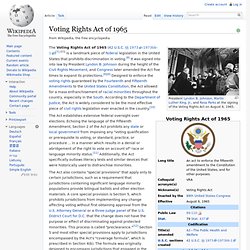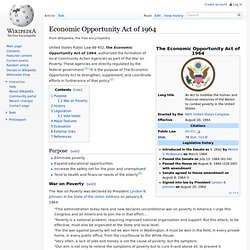

Social Security Amendments of 1965. History[edit] Many politicians were involved in drafting the final bill that was introduced to the United States Congress in March 1965.

On July 30, 1965 President Lyndon B. Johnson signed the bill into law. The concept of national health insurance began in the early 20th century in the United States and then came to prominence during the Truman administration. Between 1958 and 1964, controversy grew and a bill was drafted. Previous administrations[edit] In 1935, when President Franklin D. In 1960, the Kerr-Mills Act created the Medical Assistance for the Aged (MAA) program which gave states the power to decide which patients needed financial assistance. Johnson administration[edit] With the election of Lyndon B. The groups previously opposed to the legislation switched their focus from opposing the bill to creating new versions of it. When deliberations began in 1965, both AMA members and their suggestions were rejected. Elementary and Secondary Education Act. Lyndon B.

Johnson at the ESEA signing ceremony, with his childhood schoolteacher Ms. Kate Deadrich Loney The Elementary and Secondary Education Act (ESEA) was passed as a part of President Lyndon B. Johnson's "War on Poverty" and has been the most far-reaching federal legislation affecting education ever passed by Congress. The act is an extensive statute that funds primary and secondary education, while explicitly forbidding the establishment of a national curriculum.[1] It also emphasizes equal access to education and establishes high standards and accountability.[2] In addition, the bill aims to shorten the achievement gaps between students by providing each child with fair and equal opportunities to achieve an exceptional education. Sections of the Original 1965 Act[edit] New Titles Created by Early Amendments to 1965 Law 2008 No Child Left Behind Blue Ribbon School Logo 1966 amendments (Public Law 89-750) Title VI - Aid to Handicapped Children (1965 title VI becomes Title VII)
Voting Rights Act. The Act establishes extensive federal oversight over elections.

Echoing the language of the Fifteenth Amendment, Section 2 of the Act prohibits any state or local government from imposing any "voting qualification or prerequisite to voting, or standard, practice, or procedure ... in a manner which results in a denial or abridgement of the right to vote on account of" race or language minority status.[11] Additionally, the Act specifically outlaws literacy tests and similar devices that were historically used to disfranchise minorities. The Act also contains "special provisions" that apply only to certain jurisdictions, such as a requirement that jurisdictions containing significant language minority populations provide bilingual ballots and other election materials. A core special provision is Section 5, which prohibits jurisdictions from implementing any change affecting voting without first obtaining approval from the U.S. Attorney General or a three-judge panel of the U.S. The Economic Opportunity Act of 1964.
United States Public Law 88-452, the Economic Opportunity Act of 1964, authorized the formation of local Community Action Agencies as part of the War on Poverty.

These agencies are directly regulated by the federal government.[1] "It is the purpose of The Economic Opportunity Act to strengthen, supplement, and coordinate efforts in furtherance of that policy.[2] Purpose[edit] Eliminate povertyExpand educational opportunitiesIncrease the safety net for the poor and unemployedTend to health and financial needs of the elderly[3] War on Poverty[edit] Revenue Act of 1964. The United States Revenue Act of 1964 (Pub.L. 88–272), also known as the Tax Reduction Act, was a bipartisan tax cut bill signed by President Lyndon Johnson on February 26, 1964.

Individual income tax rates were cut across the board by approximately 20%. In addition to individual income tax cuts, the act slightly reduced corporate tax rates and introduced a minimum standard deduction.[1] Summary of provisions[edit] The Office of Tax Analysis of the United States Department of the Treasury summarized the tax changes as follows:[2] reduced top marginal rate from 91% to 70%reduced corporate tax rate from 52% to 48%phased-in acceleration of corporate estimated tax payments (through 1970)created minimum standard deduction of $300 + $100/exemption (total $1,000 max) History and effects[edit] President John F.
Kennedy was assassinated in November 1963, and was succeeded by Lyndon Johnson. National Museum of American History. Adlai Archive - Audio.